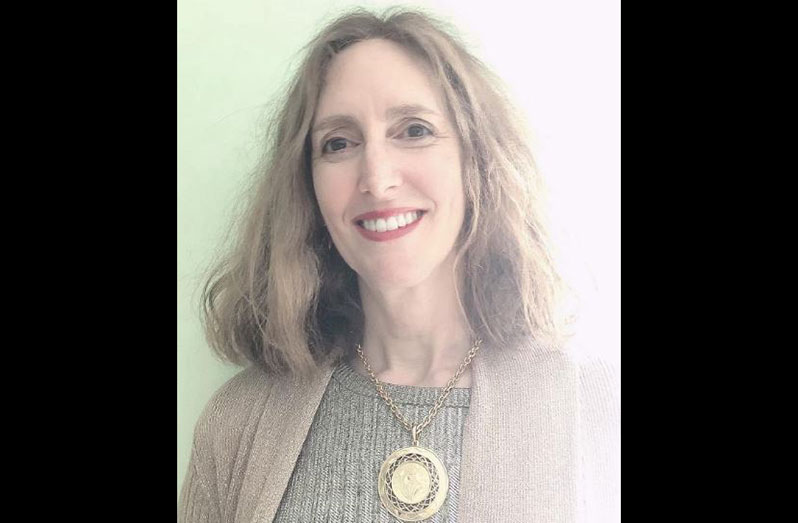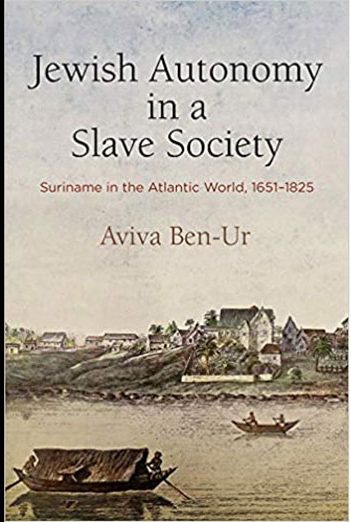PROFESSOR Aviva Ben-Ur of the Department of Judaic and Near Studies at the University of Massachusetts Amherst has authored a superlative and dazzling book titled Jewish Autonomy in a Slave Society: Suriname in the Atlantic World, 1651-1825, published by the University of Pennsylvania Press, 2020. The book explores the political and social history of the Jews of the Dutch colony of Suriname, the largest and most privileged Jewish community in the early modern Americas.
Lomarsh Roopnarine (LR): What has motivated you to write this book?
Aviva Ben-Ur (AB): My initial interest in Suriname was happenstance. In the late 1990s, a New York-based architect named Rachel Frankel hired me to transcribe and translate the epitaphs of Jewish cemeteries in rural and urban Suriname, dating from the 1660s onward. I had the requisite languages (Aramaic, French, Hebrew, Portuguese, Spanish, and soon also Dutch) and undertook three separate trips to carry out this work. We co-authored two books on Suriname’s Jewish cemeteries and an Afro-Surinamese burial ground in the Jewish village of Jodensavanne.
LR: I do admire your linguistic skills and abilities. What were some factors that contributed to the formation of Jodensavanne, located some 30 miles south of Paramaribo on the Suriname River?
AB: Authorities in the Dutch Republic sought to attract immigrants from Europe to develop Suriname economically and defend it against attacks by local Indigenous people, slaves of African descent, and Maroons (former slaves who escaped to the surrounding rainforest to forge autonomous communities). Because the economy in the seventeenth-century Dutch Republic was strong, it was difficult for authorities to convince Dutch Christians to move overseas. However, economic opportunities for Jews in the Dutch Republic were severely restricted and poverty among them endemic. The influx of refugees from the Iberian Peninsula and Central and Eastern Europe challenged fiscal management, and municipal policies barred Jews from entering certain trades, including agriculture and the military.
LR: But the Dutch Government wanted white immigrants to populate Suriname.
AB: Yes. Jewish leaders were in a powerful position to negotiate settlement on extraordinarily privileged terms. They were allowed to practise their religion, own property (including human beings), try their members in a Jewish court, run their own schools, keep records in their native Portuguese, Spanish, and Hebrew, and live in their own village, known as Jodensavanne (Jews’ Savannah). Slave auctions were not held on Jewish holidays, to allow Jewish participation.

LR: What was their role in the eyes of the colonial government?
AB: Since the area Jews chose for their village abutted the Surinamese rainforest, one of their most important tasks was to defend the White population from incursions of Indigenous people and runaway slaves.
LR: What factors led to the continuation of this community in such a challenging environment?
AB: Infectious disease was rampant in the colony, as historian Robert Cohen showed decades ago. Like other free colonists, Jews also contended with widespread economic insecurity and the continual threat of slave insurrection. Competing groups, especially Christian clerics, tried to chisel away at the privileges the Dutch colonial government had granted local Jews. The Jewish community grew partly because of immigration to Suriname. The Dutch colony received more Jewish immigrants than any port in the Americas through the eighteenth century. The phenomenon of “Suriname marriage”, a euphemism for sexual relations between a free man and an enslaved woman, was a leading factor in the survival and growth of the Jewish community.
LR: It seems like the Jewish community in Suriname was open to inter-ethnic and inter-religious marriage.
AB: Unlike White Christians, the Jewish community generally opened its doors to children born to Jewish fathers and enslaved women. While most Christians during that period did not convert slaves to their father’s religion, the Jewish community had local teachers who regularly converted select children to Judaism.
LR: I am particularly impressed with how you mapped out the evolving process of the Jewish community in Suriname during the period of the master-slave relationship. However, you also provided a narrative of the Eurafrican Jews. Who are these people and what is their relationship with the Jewish community?
AB: Eurafrican Jews were individuals born to White Jewish fathers and enslaved African mothers starting in the 1660s, the decade Jews first established their community. These fathers decided to convert some of their enslaved children to Judaism. There is indirect evidence that African mothers encouraged this conversion and perhaps even aspired to it, for both spiritual and pragmatic reasons.

LR: Okay, so when they were converted what happened?
AB: These children became bona fide Jews. If they were female, they automatically passed on their Jewishness to their own children (in rabbinical law, Jewishness transmits through the mother). The population of Eurafrican Jews grew exponentially. It is likely that by the early 1800s, nearly every Surinamese Jew had an enslaved African ancestress sometime in the previous two hundred years.
LR: Why do you think that intermarrying was so high?
AB: In slavery systems, a master owns both the labour and the body of the slave. Also, there was a dearth of White women in the colony. African mothers were key to the survival and growth of Suriname’s Jewish community.
LR: What were some circumstances and conditions that led to the abolishment of Jewish autonomy?
AB: The abolition of Jewish communal autonomy in 1825 was imposed by the metropolitan government, an attempt by the Dutch government to ensure that every free person in the colonies would be equal in civil status. The Jewish community, which had previously functioned as a government within a government, and as an ethno-religious group with self-determination, was to be transformed into a religious group almost entirely on par with Christians. In practice, however, Jews in both the metropole and Suriname continued in many respects to function as a group apart and to identify as a distinct ethnic group.
LR: What happened to Jodensavanne after abolition?
AB: By 1825, most Jews no longer lived in the rural hinterland, but continued to visit Jodensavanne to celebrate Jewish holidays. Over the years, its permanent population dwindled and Jews ceased to visit the village. By the mid-nineteenth century, it was largely abandoned by the Jewish community. Local non-Jews, some of whom had been owned by Jewish families, claimed de facto ownership of the village.
LR: What would you like readers to know about your book that I might not have asked?
AB: When I wrote my book, I wanted to avoid speaking about Suriname as exceptional. It had so much in common with other slave societies and was part of a unified system known as the Atlantic World. I sought to normalise the history of Jews in Suriname by centering slavery and the framework of the Atlantic World, with its incessant movement and circulation of people, goods, ideas, technology and diseases.
LR: What is your future plan regarding the Jewish community in Suriname?
AB: My dream is to learn Sranan Tongo, the lingua franca of Suriname. Although I have moved on to other projects, I also look forward to continuing my collaboration with my colleagues in Suriname, particularly the officers of Jodensavanne Foundation (Stichting Jodensavanne).
LR: Thank you for a great interview.




.png)









